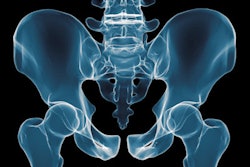
A group from the University of California, Los Angeles (UCLA) was able to slash the number of unnecessary stat portable pelvic radiography studies that were being performed in addition to CT scans for trauma patients, according to an article in the September issue of the Journal of the American College of Radiology.
The team of first-year radiology residents led a quality improvement project that brought together stakeholders from the radiology, emergency, and trauma surgery departments. Their goal was to investigate the feasibility of a diagnostic algorithm to replace an existing protocol that called for both radiographs and CT scans to be conducted on all trauma patients.
They found that CT provided nearly all the diagnostic information needed to work up patients who were hemodynamically stable, enabling UCLA to reduce the use of stat portable pelvic radiography exams by 60% in these individuals (JACR, Vol. 12:9, pp. 954-959).
An imaging dinosaur?
UCLA's diagnostic protocol for trauma patients called for a stat portable pelvic radiograph regardless of how the patient was injured, whether there was presence of pelvic injury, or whether there was a concurrent order for a stat pelvic CT scan. In many cases, the pelvic radiographs were interpreted after the pelvic CT scan, and new pathology was rarely discovered on the x-ray, according to Dr. Kambiz Motamedi.
 Dr. Kambiz Motamedi supervised the quality improvement project.
Dr. Kambiz Motamedi supervised the quality improvement project.Motamedi said that use of the algorithm at UCLA dated back decades, to a time when CT scans took 10 minutes to perform and scanners were often located outside of emergency departments (EDs), with precious time lost to patient transport. Back then, stat pelvic portable radiographs enabled emergency and trauma physicians to view a patient's pathology immediately and decide on a course of action.
Now, many EDs operate their own CT scanners, and studies are performed in as little as 90 seconds. In this environment, requiring both radiographs and CT scans for all patients was an outmoded practice, Motamedi said.
"We realized this practice was a dinosaur," he told AuntMinnie.com. "CT pelvis scans are a lot more sensitive in looking for fractures, so the pelvis radiograph was a waste of money and resources."
Motamedi therefore assigned a review of the policy to the first-year class of 12 radiology residents as part of their required quality improvement project.
Led by residents Dr. Jessica Langer, Dr. Emily Tsai, and Dr. Aarti Luhar, the group worked with faculty mentors to develop a new algorithm that would cut the number of stat pelvic radiographs in hemodynamically stable trauma patients, reducing both radiation exposure and healthcare costs, Motamedi said.
Literature review
The group's first step was to perform a literature review on existing guidelines for stat portable pelvic radiography in trauma patients. From an initial 120 articles, they narrowed their search down to nine studies, all of which recommended against pelvic x-ray if pelvic CT scans were planned and patients were hemodynamically stable.
Next, the group performed a chart review of hemodynamically stable trauma patients seen over a three-month period, from February to April 2012, collecting various data on patient demographics and outcomes.
Both the literature and chart reviews were used to develop a new diagnostic algorithm for ordering pelvic imaging. The algorithm advised that stat pelvic radiography not be used if three key triage points were met:
- The patient was hemodynamically stable
- There was a lack of evidence of pelvic injury from physical exam findings
- Physicians already intended to obtain a pelvic CT image
The algorithm was approved in February 2013 by a multidisciplinary trauma subcommittee that included representatives from the radiology, emergency, and trauma surgery departments.
The algorithm was rolled out in the emergency department that May, and cards describing the protocol were distributed to emergency and trauma personnel. To see how it was working, the researchers performed chart reviews for 131 trauma patients at one, six, and 10-12 months after implementation. The study's primary outcome was the proportion of trauma patients who received both pelvic portable radiography and CT scans.
What did the group find? At the one-year follow-up point, the number of stat pelvic radiography studies had fallen 60% in trauma patients who also had CT scans.
| Percent of patients receiving both stat pelvic radiographs and CT scans | |
| Follow-up interval | Percent |
| Prior to implementation | 77.9% |
| 1 month | 25.7% |
| 6 months | 24.3% |
| 12 months | 17.8% |
The project wasn't without complications. The group found that requests for stat portable pelvic radiographs were sometimes still included in trauma order sets, regardless of the nature of the patient's injuries. So, radiologic technologists were instructed to verify that a portable pelvic radiograph was indicated before acquiring the image, regardless of whether an order was in the system. This can be difficult in a busy emergency department, the researchers noted.
Indeed, due to workflow concerns in the trauma department, they decided not to change the policy in which stat radiographs were automatically included in pelvic trauma order sets. Instead, they have told radiologic technologists to perform the radiographs only if they have a verbal order from someone on the trauma team.
"In a critical trauma case there is no time to remove orders, so they want to keep [the automatic order] in there," Motamedi said. "But radiology wouldn't automatically shoot [the study] unless they get a verbal approval."
Motamedi cited the fact that the group engaged physicians from multiple departments early on as a major factor in the project's success.
"Early and continued engagement of stakeholders enabled a multidisciplinary approach to the development, implementation, and postimplementation follow-up of the trauma algorithm," the authors wrote.



















